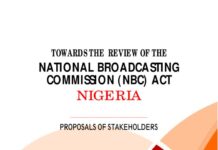“The art of the reporter should more than anything else be a celebration of the truth … The fundamental obligation of the reporter is to truth.” – Kergal Keane
The media play a very important role in any democratic society. It is the duty of the press to educate, inform, entertain and conscientise the people. This helps in building a politically conscious masses or electorates that can make informed decisions. The press is regarded as the ‘fourth estate of the realm’ principally because of the role in holding government to account. Thomas Jefferson in acknowledging the role of the press said: “Were it left to me to decide whether we should have a government without newspapers, or newspapers without a government, I should not hesitate a moment to prefer the lather.” This further underscores the place of the media in shaping and building the society. However, for the media to continue playing this role requires commitment to the core principles of journalistic practices as enshrined in the code of ethics of professional journalists. The Code of Ethics for Nigerian Journalists points out “journalism entails a high degree of public trust. To earn and maintain this trust, it is morally imperative for every journalist and every medium to observe the highest professional and ethical standard”. It is this that confers integrity on the media.
Fake news are falsehood, conjectures, pernicious propaganda or half truth which are intentionally passed on as truth and authentic information or stories intended to mislead and achieve sinister objectives or financial gain. Fake news is nothing new in journalism. There was the ‘Yellow Journalism’ with its overtly concocted and sensational stories several decades ago. However, the explosion in social media platforms and how technological companies operate has made the problem pervasive.
Dr. Kristen Dembroski outlines the following as attributes of fake news: Purpose – Misled; spread misinformation; false or propaganda published under the guise of authentic news; sensationalist; extreme; fuels passions and prejudices; may provoke violence. The American presidential election of 2016 made false journalism and fake news blossom and become a treat to the mainstream traditional journalism. Anders Hofseth summed it up saying that “The media of the world may be facing a crisis more serious than a media economy in a freefall, a crisis involving the foundations itself: Trust. Not the trust in the single news piece or the single publication, but the entire idea of editorially controlled news media”.
When the audience no longer trusts the information in the media, then the integrity of the media is already undermined. In this situation there is dissonance and they would have to look for multiples sources to validate the authenticity of the information or news. But the audience by nature may not have all the time because they have other things bordering them – jobs to do, dates to keep, meetings to attend, numerous other things occupying their time and mind. This may result in apathy for media contents. Hofseth argues that “by itself, fake news poses little threat beyond the need for increased alertness. But fake news attacks society’s system for information sharing. It’s casting shadows of doubt over the credibility of media, and creating the impression that the media is offering just one of several possible truth, thus making it sort of optional which fact you care to relate to”. This mirrors John Milton’s didactics in his Agreopagitica. But unlike Milton, the situation creates a vacuum because the society’s information system has been dislocated, devalued and news or information becomes what anyone can distill from an event. This is akin to relativism.
Fake news is more rampant in the internet because of the way social media and some news platforms operate. Facebook for example have always denied being a news platform claiming that it is only a technology company. Consequently, the platform is not bound by ethical and professional conduct of the traditional media outlets or organisations. It was only recently after much outcry by the public and industry players that it reluctantly decided to take down or block lots of fake news and dubious materials. Aidan White admonished facebook saying “facebook would do well to stop denying it is a publisher and face up to its responsibility as a news provider”. He further stated that “it needs to recorgnise and apply the principle and standards of journalism and free expression that have guided the work of journalism, editors and publishers”. It is this lack of accountability that has made fake news flood the social media and other websites. Today, millions of people get their news through these platforms. “Integrity, authority, humanity and evidence: Are there better words in the lexicon of journalists? This was the question Lyse Doucet, BBC chief International Correspondent asked in her acceptance speech as she received the 2017 British Journalism Review Charles Wheeler Award for Outstanding Contribution to Broadcast Journalism. Sadly, fake news is just an off shoot of post –truth era where there exists not just ‘Truth’ and ‘lie’ but the third ‘Ambiguity’ where people grope and pick which information they relate to.
The basic danger in fake news is that it makes people doubt almost every news or information and this can be very destabilising to any society. Think of a situation where people no longer believe in any information coming from the authorities or politicians – it is the beginning of social breakdown. This is a threat to democracy, modern society and reality. In his Agreopagitica, John Milton averred “Though all winds of doctrine were let loose to play upon the earth, so truth be in the field, we do injuriously by licensing and prohibiting to misdoubt her strength. Let her and falsehood grapple; who ever knew Truth put to the worse in a free and open encounter”. This position is seriously being challenged by the level of fake news in the internet and out there. For Gary Kasparov, “If you can convince people that real news is fake, it becomes easier to convince them that your fake news is real”. He further submits that “The point of modern propaganda isn’t only to misinform and push an agenda, it is to exhaust your critical thinking, to annihilate the truth”. This is the major problem since news then teeters dangerously towards relativism.
And this is why Stuart Allen believes that “More than a question of semantics, the nature of proper identity to be affirmed by the journalist within a democracy continues to be hotly contested… nowhere have the tacit assumptions informing a collective sense of identity been more openly challenged than by the emergence of the ‘citizen journalism’ movement … citizen journalism has succeeded in rattling the foundations of the craft” Prompt identification of fake news is one way of ensuring that it does not spread but this may not be that easy. Applying logic and common sense is very essential. When one looks closely and pitches the facts together, one can clearly see the bigger picture. Checking out other credible sources can help to know the status of the story. It is important to check the Uniform Resource Locator (URL), the title and other graphics to know whether it is old information that is being presented in a new context or whether some trusted media sites have been impersonated or faked. African Independent Television (AIT) has been a victim.
Credible media organisations are ready to publish correction and retractions but not fakes. Also, if there are so much inappropriate materials pop ups and other embedded links, it is a red flag. The address and other contacts of the author should be clearly stated and functional and it is very important to check out if the information or story is loaded with strong, emotional or absolute language. Is the language moderate? Media literacy is a way of battling fake news. This involves the understanding of how the news sources and media work. If the audiences are knowledgeable the problem will be reduced because fake news exits because of money from advert and political patronage. Most platforms that disseminate such stories aims at attracting traffic – number of visits and time spent on the websites.
Seeking out truth and also giving out prompt accurate and truthful information is important. Moreover, news sources must build trust and integrity in order to be believed. For example, in a shooting at the YouTube headquarters in San Bruno, California, U.S, on April 3, 2018, Chief Ed Barberini of the San Bruno Police department was on hand giving press statement on the unfolding situation. This prompt release of relevant information helps in checking speculations and fake news.
Prof. Lai Oso, president, Association of Communication Scholars and Professionals of Nigeria (ACSPN) advised that “government needs to be more forth coming in terms of its public communication functions. It is not when things have gone to a very low level that it begins to panic about information; it must be concerned about credible information.” Many reputable social media, online news platforms and blogs are veritable sources of news if managed by credible professionals that adhere to the journalistic code of ethics of accuracy, impartiality, objectivity, truthfulness and public accountability. If fake news are promptly identified and debunked or set straight by the trusted credible media organisations, it will go a long way in checking the pervasiveness and threat of fake news. In this, it not enough to tell the news but also telling what is ‘no news’ as it breaks.
Uja, a research officer, wrote from Abuja.
















